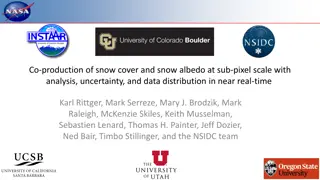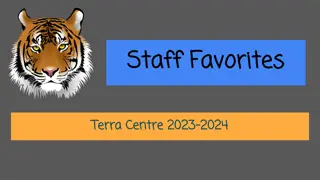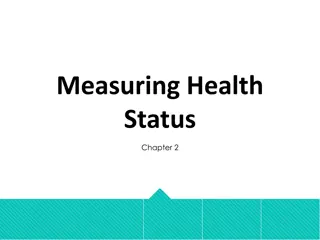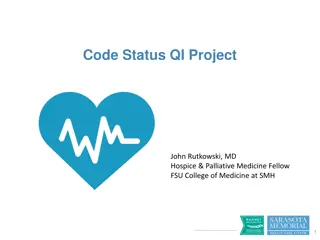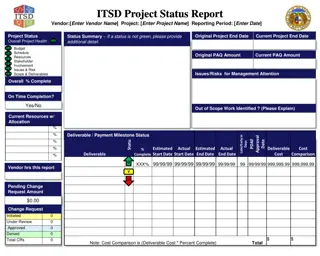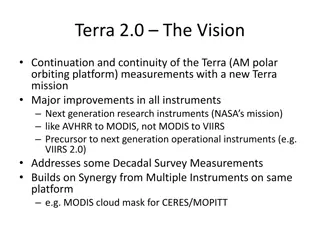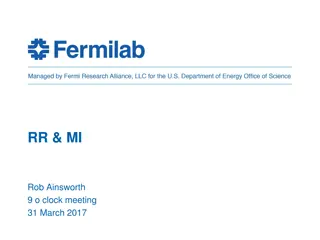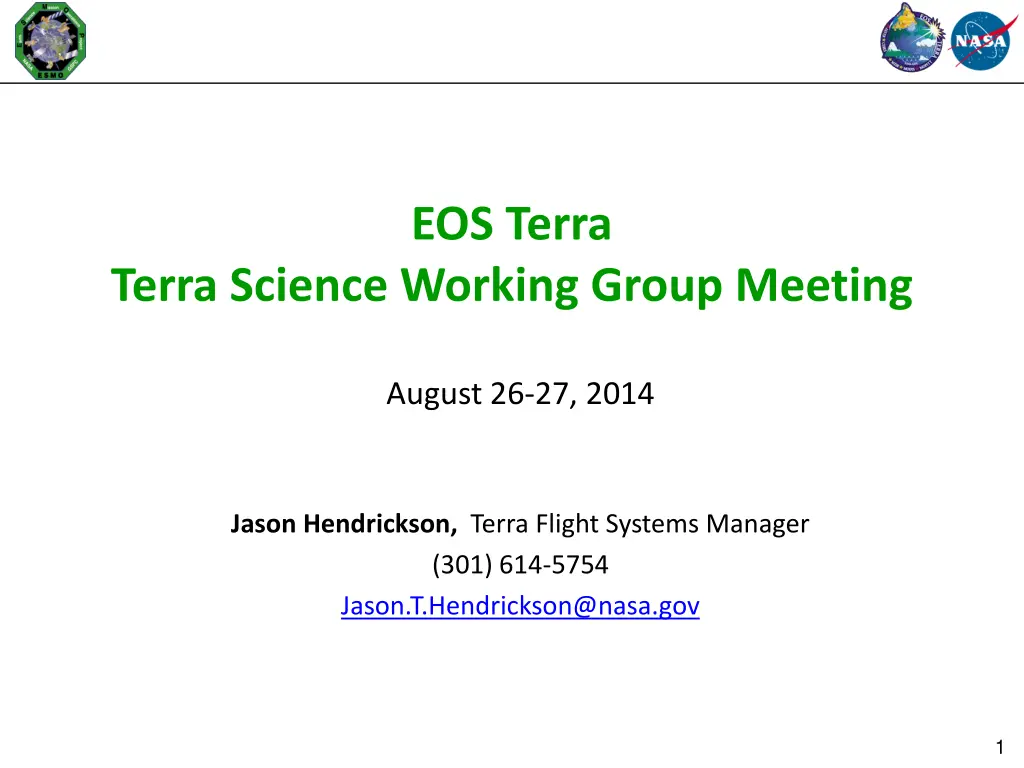
Terra Spacecraft Status Update
"Get the latest update on Terra spacecraft status, including subsystem and instrument conditions, anomalies, and operational highlights since August 2013. Stay informed about the data capture rates, recent maneuvers, and notable occurrences affecting the Terra mission."
Download Presentation

Please find below an Image/Link to download the presentation.
The content on the website is provided AS IS for your information and personal use only. It may not be sold, licensed, or shared on other websites without obtaining consent from the author. If you encounter any issues during the download, it is possible that the publisher has removed the file from their server.
You are allowed to download the files provided on this website for personal or commercial use, subject to the condition that they are used lawfully. All files are the property of their respective owners.
The content on the website is provided AS IS for your information and personal use only. It may not be sold, licensed, or shared on other websites without obtaining consent from the author.
E N D
Presentation Transcript
EOS Terra Terra Science Working Group Meeting August 26-27, 2014 Jason Hendrickson, Terra Flight Systems Manager (301) 614-5754 Jason.T.Hendrickson@nasa.gov 1
Section 1 SPACECRAFT STATUS 2
Spacecraft Status Summary 98.53% Data Capture since July 2013 (99.97% ASTER) Terra Spacecraft Subsystem and Instrument Status Aug-13 Green3 Green Yellow2 Green Green Green Green4 Sep-13 Green3,6 Green Yellow2 Green Green Green Green4 Oct-13 Green3,6 Green Yellow2 Green Green Green Green4 Nov-13 Green3 Green Yellow2 Green Green Green Green4 Dec-13 Green3 Green Yellow2 Green Green Green Green4 Jan-14 Green3 Green Yellow2 Green Green Green Green4 Feb-14 Green3 Green Yellow2 Green Green Green Green4 Mar-14 Green3 Green Yellow2 Green Green Green Green4 Apr-14 Green3 Green Yellow2 Green Green Green Green4 May-14 Green3,6 Green Yellow2 Green Green Green Green4 Jun-14 Green3 Green Yellow2 Green Green Green Green4 Jul-14 Green3 Green Yellow2 Green Green8 Green Green4 CDH COM EPS FSW GNC NAV TCS Green1 Green Green Green Green Green1 Green Green Green Green Green1 Green Green Green Green Green1 Green Green Green Green Green1 Green Green Green Green Green1 Green Green Green Green Green1 Green Green Green Green Green1 Green Green Green Green Green1 Green Green Green Green Green1 Green Green Green Green Green1 Green Green Green Green Green1 Green Green7 Green Green ASTER CERES MISR MODIS MOPITT 1 ASTER SWIR is no longer providing usable science data. No further recovery attempts planned. SWIR data processing turned OFF 8/21/13 2 Hex Bay Battery (BBAT) cell #50 failed and multiple BBAT heater control groups failed on 10/13/09. 3 Terra Master Oscillator (MO) shifts caused unexpected changes in the Terra clock correlation error drift rate from (Oct 2010 Dec 2011). This anomaly has stabilized in the last year and there are no concerns at this time. 4 ASTER TIR CPHTS reservoir line temperature fluctuations (20 occurrences in 2013, 13 occurrences in 2014). 5 Skipped EDU in ASTER buffer. Occurred on 8/12/12 and 2/5/13 . One to four seconds ASTER data loss each time 6 A Science Formatter Equipment Side A (SFE-A) Anomaly occurred on 09/23/13 (Data loss 1:18:55) and 10/23/13 (Data loss 1:28:55). The last SFE-A Anomaly occurred on 5/24/14 (Data Loss 00:05:52), the large reduction in data loss is due to the updated SFE-A TMON response that autonomously recovers the SFE-A. 7 MISR Halt Anomaly occurred on 7/8/14 and was a SEU resulting on MISR no longer outputting data and the FOT running a Red Limit Response to power MISR OFF. MISR was successfully returned to Normal Operations 8/1/14. 8 ACE-B Sensor Select Anomaly occurred on 7/5/14, new TMON immediately responded and returned the ACE-B to the correct configuration. 3
2014 Highlights (Maneuvers) Calibration Maneuvers MODIS Roll #135 executed on 1/21/13 MODIS Roll #136 executed on 2/19/13 MODIS Roll #137 executed on 3/21/14 MODIS Roll #138 executed on 4/19/14 MODIS Roll #139 executed on 5/18/14 MODIS Roll #140 executed on 6/17/14 MODIS Roll #141 executed on 7/16/14 MODIS Roll #142 executed on 8/14/14 Next MODIS Roll #143 Propulsive Maneuvers DMU #79 executed on 01/31/14 (with new Solar Array operations) DMU #80 / DAM #6 completed successfully on 2/9/14 IAM #37 successfully executed on 2/12/14; CAM on 2/11/14 IAM #38 successfully executed on 2/26/14; CAM on 2/25/14 DMU #81 executed on 3/14/14 DMU #82/DAM #7 executed on 03/21/14 DMU #83 executed on 04/25/14 DMU #84 executed on 7/22/14 4
2014 Highlights (Improved SFE Anomaly Response) Improved Science Formatter Equipment (SFE) Anomaly Telemetry Monitor (TMON) #16 Response On 01/29/14 the Flight Operations Team (FOT) updated the response for the SFE Anomaly TMON The updated response includes an autonomous SFE recovery TMON-16 detects approximately 70% of SFE Anomaly cases Updated response will reduce SFE data loss for those cases from ~1.5 hours to ~6 minutes. Occurrence Post TMON Update On 05/24/14 the SFE anomaly reoccurred for the first time since the TMON update TMON -16 successfully autonomously recovered the SFE-A Total Data loss for each Buffer was only 5 minutes and 52 seconds SFE TMON update reduced SFE Anomaly data loss by 99.93% from 2013 occurrences 5
2014 Highlights (MOPITT CPHTS Test) MOPITT Capillary Pumped Heat Transport System (CPHTS) Heater On Test Between 4/2/14 and 4/5/14 the FOT coordinated with the MOPITT IOT to perform a power loading test with the MOPITT CPHTS The MOPITT CPHTS Heater was turned on Similar activity to SWIR CPHTS Heater On Cooler Off Test MOPITT CPHTS activity did not require set point changes or turning off the cooler Intended to increase power loading Could be used to offset reduced power draw in future and maintain BBAT Temperatures Saw expected 75 W increase in load BBAT temperatures increased 0.65 C increase on coldest cells MOPITT CPHTS Test Successful 6
2014 Highlights ACE-B Sensor Select Anomaly Recovery (7/5/14) Between Launch and 2011, the ACE-B sensor selection has spontaneously changed configuration to an undesirable state three (3) times caused by a Single Event Upset (SEU) ACE-B Sensor Selection only used for in event of an SCC Halt When the ACE-B sensor selection is misconfigured, a SCC halt would result in Earth Pointing Safe Mode with diminished attitude control TMON #7 was uplinked 4/3/14 to automate the response to resets the ACE-B Sensor Selection to it s nominal configuration (ESA_GYC on all axis) On 7/5/14 (2014/186) at 06:51:59 the ACE-B experienced another SEU and TMON #7 tripped Anomalous configuration o Roll = IRU; Pitch = No Sensor; Yaw = No Sensor (same as 2011/293 occurrence) TMON #7 Successfully returned ACE-B Sensor select to its nominal configuration o Roll = ESA_GYC; Pitch = ESA_GYC; Yaw = ESA_GYC TMON #7 Processing was re-enabled at 08:16:21 New TMON Recovered from ACE-B Anomaly resulting in NO IMPACT 7
2014 Highlights MISR Survival Transition (7/8/14) On DOY 189 2014 (7/8/14) at 13:46:41 in the back-orbit MISR stopped outputting data Most of MISR Telemetry stopped updating (Only BDU Telemetry remained valid) and went to null values resulting in several Red Limit Violations MISR TMONs also reported an error of Stale data At AOS of the next contact at 13:49:51 the OCE saw 15 MISR Red Alarms and 2 MISR Yellow Alarms and ran the Red Limit Responses which configured MISR to Survival As a result of MISR Survival SSR Automation was suspended since MISR Buffer is empty The FOT also set Inhibit ID 20, 23, and 25 to prevent MISR ATC commands from being processed MISR determined the cause of the anomaly was likely an SEU that initiated a CPU Reboot, and the PROM software reload failed to complete Either due to a known MISR idiosyncrasy or the TAXI OFF command in the ATC during reload MISR successfully completed recovery back to science Phase 1 of their recovery (Power On) on July 24th Phase 2 of their recovery (Reloaded FSW & Return to Science) on July 31st & August 1st MISR Team reported, late on 8/01, that data appears the same as pre-anomaly data MISR back in Normal Science Operations 8
Science Data Capture Statistics Month June 2013 July 2013 August 2013 September 2013 30 October 2013 November 2013 30 December 2013 31 January 2014 February 2014 28 March 2014 April 2014 May 2014 June 2014 July 2014 Days 30 31 31 Tbits Capture 37.46 38.01 33.20 29.32 35.52 34.74 37.13 37.93 32.01 37.62 36.10 36.99 38.36 34.63 Reason for Data Loss 99.98% Negative Acquisition 100.0% N/A 99.99% K-band hit in MISR/WSC Issue 99.84% SFE-A Anomaly 99.74% SFE-A Anomaly/Ops Errors 99.99% Missed Lock Up Replay/Bit Flip 99.99% Incorrect Lock Up replay 100.0% N/A 99.85% WSC Issue 100.0% N/A 100.0% N/A 99.98% SFE-A Anomaly 99.99% Incorrect Lockup Replay 83.57% MISR Anomaly 31 31 31 30 31 30 31 9
Terra Collision Avoidance Activities High Interest Events (HIEs) Year Jan Feb Mar Apr May Jun Jul Aug Sep Oct Nov Dec Total 2013 (T1-T4) 0 2 6 3 1 1 0 2 1 0 1 0 17 Tier 3 0 1 2 1 0 0 0 1 1 0 1 0 7 Tier 4 0 0 1 0 0 0 0 1 0 0 1 0 3 2014 (T1-T4) 1 2 3 1 1 2 1 11 Tier 3 0 2 1 1 0 1 0 5 Tier 4 0 2 1 0 0 0 0 3 CARA Defines the 4 Tiers as: T1 Notify (email/phone), T2 Conduct Briefing, T3 Plan Maneuver, T4 Execute Maneuver 2005: 4 HIEs 1 Risk Mitigation Maneuver (RMM ) performed on 10/21/2005: Terra vs. 14222 CA on 10/23 2006: 1 HIE 1 maneuver waived off due to CA. Maneuver originally planned for 01/12/2006: Terra vs. 1716 CA on 1/12@ 17:46z 2007: 4 HIEs 1 RMM performed on 06/22/2007: Terra vs. 31410 CA on 6/23 2008: 2 HIEs 1 RMM planned and waived off: Terra vs. 82832 CA on 10/28/2008 @ 06:17z 2009: 2 HIEs No RMMs planned or performed 2010: 5 HIEs 1 RMM performed on 01/22/2010: Terra vs. 34700 CA on 1/23 @ 20:46z 2011: 20 HIEs 2 RMM planned and waived off: (1) Terra vs. 26181 CA on 3/28/2011 @ 12:14z (2) Terra vs. 30440 Repeating CA 05/07-09/2011 2012: 19 HIEs 1 maneuver waived off due to CA. Maneuver originally planned for 05/31/2012: Terra vs. 37789 CA on 6/1 @ 22:49z 2013: 17 HIEs 7 that required significant action 2014: 11 High Interest Events (HIEs) 5 that required significant action 02/09/2014: RMM executed successfully for Terra vs. 26347 CA on 2/10 @ 11:52z 02/21/2014: Terra IAM#38 waived off due to post-maneuver conjunction concern, rescheduled and executed on 2/26/2014 03/21/2014: DAM executed for Terra vs. 9040 CA on 3/23 @ 00:17z Rate of HIE continues to be high 10
EPS Performance Bus Load: Nominal Average bus load: 2280 Watts average housekeeping current: 11.94 A; Total instrument current: 7.150 A Battery Performance: Nominal with exception of anomalous BBAT condition BBAT cell # 50 failed following IAM #24 on October 13 (DOY 286) 2009 BBAT heater control electronics (HCE) anomaly occurred following IAM #24 on October 13 (DOY 286) 2009 At least 4 of 9 BBAT heater groups are no longer being controlled Heater control setpoints changed for controllable heater groups to reduce the thermal gradient PBAT Charge/Discharge Ratio was reduced from 105% to 104% on April 25, 2013 to extend PBAT life PBAT BPC Channel A Disabled January 14, 2014; increases BBAT cold temperatures due to increased discharge Reduced BBAT Heater 1-3 Setpoints May 19-23, 2014; for further reduction of thermal gradient Reduced BBAT Heater 6 Setpoint June 10, 2014 Battery Temperatures: Nominal with exception of anomalous BBAT data Battery Voltages (BBAT) Minimum battery voltages at 66.10 Volts Solar Array Last offset adjustment performed on August 13th 2014 NO IMPACT TO SCIENCE 11
EPS Process Improvements 1) New Solar Array Operations Since 2013, to reduce stress on the battery and streamline DMU execution, the Terra Solar Array (SA) has been managed to maximize charging while avoiding plume impingement danger regions by using more flexible SA parking locations and SA rotation rates 2) Raised average BBAT Cell temperatures by disabling BPC Channel Successfully executed Jan. 14, 2014 Raised average BBAT cells temperatures by 1 degree (2 degrees for coldest cell) This improves our contingency posture in the event of a load shedding incident and reduces the thermal gradient of BBAT (reduces uneven wear) 3) Implemented improved response to HCE Anomaly In 2009 a Single Event Upset (SEU) on the Heater Control Electronics (HCE) disabled heaters on BBAT and PBAT A telemetry monitor (TMON) was developed and successfully uplinked Feb. 20, 2014 to immediately recover from the anomaly and ensure the heaters are re-enabled 4) Lowered BBAT Heater Set Points From 5/19/14 to 6/10/14 the FOT reduced the set points for BBAT heaters 1, 2, 3, and 6 by 1 C This reduced the BBAT thermal gradient by 0.5 0.75 C, reducing uneven wear on BBAT cells 12
BPC Channel Disable Overview Background / Purpose Following the 2009 BBAT Anomaly, Battery Cell temperatures dropped and became much colder than normal. The FOT has stabilized temperatures since anomaly The FOT is constantly looking for ways to improve temperatures. This will improve our ability to respond to future anomalies, and prolong battery life and mission life to be able to support science The purpose of this activity was to generate more heat in BBAT by shifting load and causing more discharge from BBAT. With 1 BPC1 (PBAT) channel disabled, BBAT will now take ~57% (4/7ths) of the discharge load This test was one of many options that the FOT is pursuing in an effort to increase battery temperatures, improve future anomaly response, and prolong mission life. 13
BPC Channel Disable Overview DOY 014 BPC Channel Disable effect on Battery Discharge 60 50 % of Total Discharge Current 40 PBAT 30 BBAT 20 10 Yellow Arrows Power flow during DAY Green Arrows Power flow during ECLIPSE 0 Before After All discharge is distributed equally across enabled channels With one PBAT channel disabled, more total current (57%) is drawn from BBAT, generating more heat during discharge 14
ASTER Skipped EDU History ASTER Skipped EDU Trend 25 20 Skipped EDU # 15 10 5 0 1/1/2000 1/3/2001 1/6/2002 1/9/2003 2/3/2012 2/5/2013 2/8/2014 1/12/2004 1/14/2005 1/17/2006 1/20/2007 1/23/2008 1/25/2009 1/28/2010 1/31/2011 The cause has been isolated to the Solid State Recorder (SSR) Data Controller Unit (DCU). The recommendation from the spacecraft manufacturer was to accept DCU performance and minimize data loss by initiating replay immediately following skipped EDU or consider swapping to redundant DCU (also referred to as SSR2). Results in minimum Data Loss of 1 EDU Block (~396 CADUs) approximately 1-5 seconds 15
CPHTS Performance CPHTS MOPITT = Nominal SWIR = Nominal TIR = Nominal except as noted below: Experiencing Random Temperature Fluctuations not related to maneuvers. Observed maximum of 5 in a 24 hour period in 2011 No fluctuations between January 2014 and early May 2014 The last fluctuation was on 2014/205 (July 24th, 2014) Occurrences of Reservoir Line Fluctuations in 2014 5 Fluctuations that Occurred in 1 day 4 3 2 1 0 0 50 100 150 200 250 300 350 DOY 16
Fuel Remaining (with MLT drift) Based on predicted fuel usage, Terra has enough fuel to support science requirements until 2020 and possibly beyond Will be discussed in more detail during Constellation Exit presentation Definitive End of IAMs Predictive Fuel to Exit Constellation Constellation Exit Unusable Fuel 17
Future Plans Upcoming Activities ASTER Interface Meeting at GSFC August 12 14, 2014 MODIS Roll #142 August 14, 2014 Terra Fall 2014 Inclination Series Strategy Meeting August 20, 2014 Terra Science Working Group August 26 27, 2014 Terra FSSE CCB September 4, 2014 Terra Fall 2014 Inclination Series October 2014 SCC2 recovery Simulation 3Q2014 Terra RTCS DMU Improvements 3Q2014 Update Drag Scale Factor 4Q2014 Activity log PB and SA adjusts, improve SSR automation via FSW 4Q2014 Terra 15 Year Anniversary December, 18, 2014 HGA Model/Keyhole Unwind; MMS Dev - HGA Gimbal motor sun exposure model 1Q2015 18
Summary Terra remains very healthy 14+ years into the mission Electrical Power Subsystem performance has been stabilized following 2009 anomaly Fuel Remaining to continue operations to 2020 and beyond Data Capture percentages continue at ~100% Collision Avoidance events are increasing in frequency FOT continues to monitor all trends/anomalies FOT continues to come up with new ideas/process improvements to maximize mission life and efficiency 19
Acronyms ATC BBAT BPC C/D CA CPHTS DAM DAS DCU DMU EDU ESA FOT FSW HCE HIE IAM IOT LM MLT MO PBAT RMM RTCS Automated Time Commands Hex Bay Battery Battery Power Conditioner Charge/Discharge Conjunction Avoidance Activity Capillary Pumped Heat Transfer System Debris Avoidance Maneuver Direct Access System Data Control Unit Drag Make-Up Engineering Data Unit Earth Sensor Assembly Flight Operations Team Flight Software Heater Control Electronics High Interest Event Inclination Adjust Maneuver Instrument Operations Team Lockheed Martin Mean Local Time Master Oscillator Power Equipment Module Battery Risk Mitigation Maneuver Relative Time Command Sequence S/C SA SCC SEU SFE SSR TMONs WRS Spacecraft Solar Array Spacecraft Control Computer Single Event Upset Science Formatter Equipment Solid State Recorder Telemetry Monitors World Reference System 20 20

